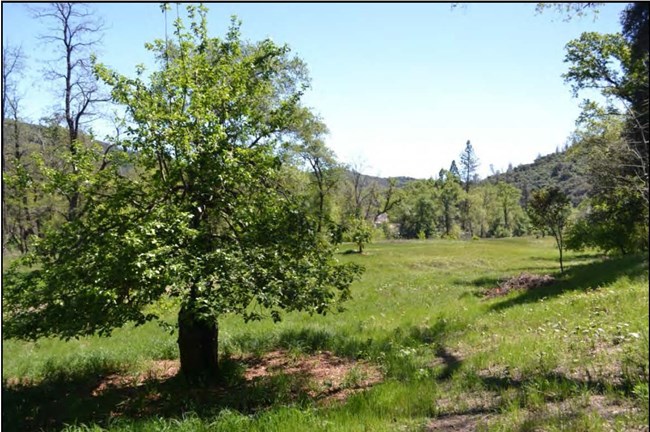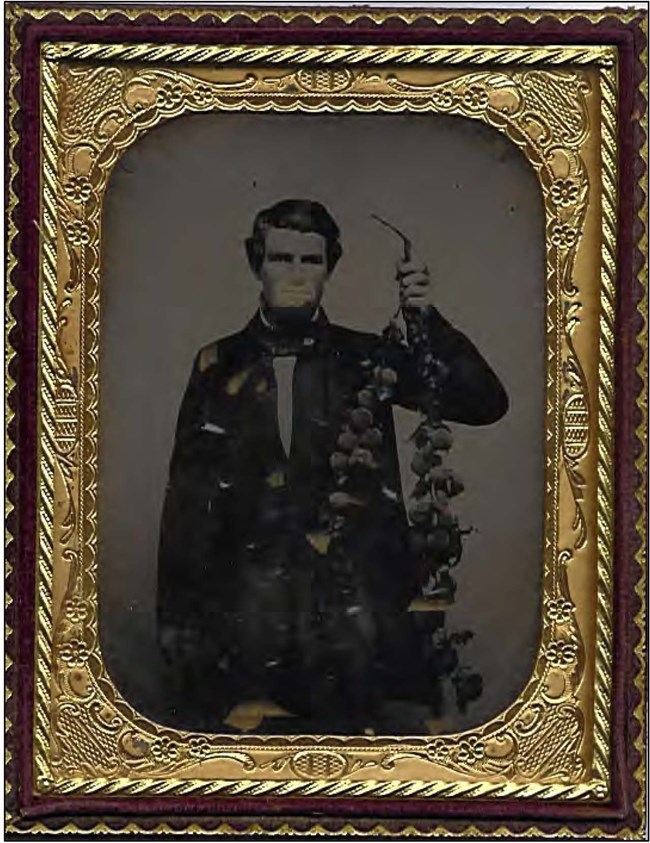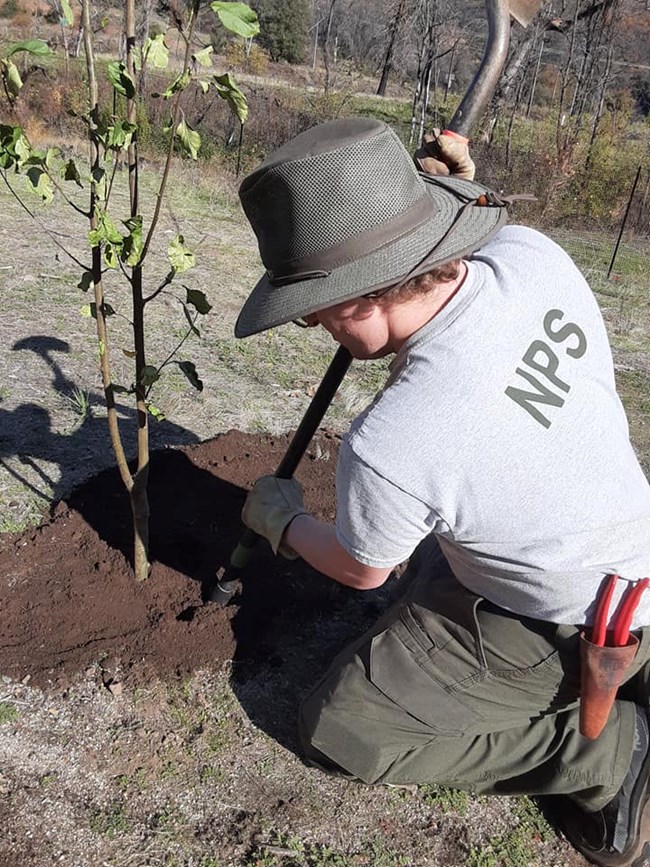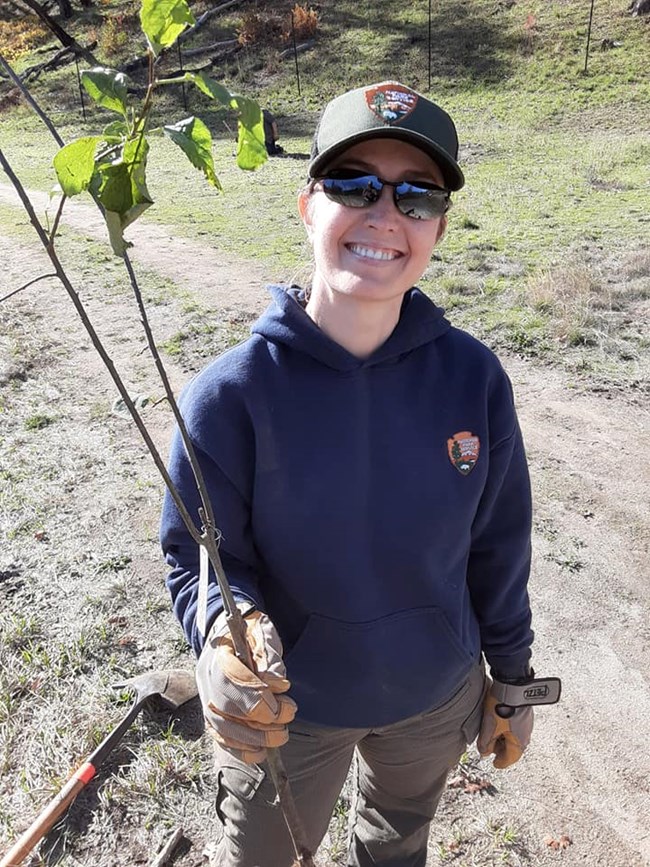Part of a series of articles titled Using Science to Preserve the Past.
Article
Orchard Rehabilitation Planting at Whiskeytown National Recreation Area

NPS

NPS / PWR Cultural Landscapes Program
In November 2021, staff from Whiskeytown National Recreation Area, John Muir National Historic Site, and SMART Workforce Center in Redding, California met at the Tower House Historic District of Whiskeytown National Recreation Area to re-establish an apple orchard.
The rehabilitated orchard was planted in an area called the Back Field that was once home to an expansive fruit orchard. An Interim Orchard Management Plan was completed for the Tower House Historic District in 2016. In preparation for future orchard treatments, the park also completed genetic testing and phenotypic identification on the fruit trees. However, in 2018, the over-200,000 acre Carr Fire burned vast portions of the park, including all of the four historic orchard areas within the Tower House Historic District. The historic Camden House itself was saved, but many of the old fruit trees dating to the late 1800s were lost.
Tower House Historic District Orchards
In 1851, Levi Tower posted a claim for a parcel of land in what is now Whiskeytown National Recreation Area in Northern California. It was a site of both natural and entrepreneurial opportunity, positioned at the confluence of three drainages and the junction of two trails leading to nascent mining districts n the upper Sacramento River valley. It was here that Tower established a hotel.

NPS / Whiskeytown National Recreation Area
Before long, he planted extensive orchards and gardens to provision the hotel operations, raised hogs and chickens, and grew sufficient hay to supply his own livestock as well as that of his customers. Over time Tower and the Tower House gained a reputation for graciousness and a high standard of service, perhaps uncharacteristic for the mining frontier. Tower's operation attracted other businesses as well, such as the California Stage Company, which chose this location for a stage stop and point of transfer for its stage line heading north toward Yreka.
The cultivation of fruit and nut trees associated with the Tower House began as early as 1853. Historical documentation suggests that Tower procured fruit and nut trees from many different sources. By the late 1840s and early 1850s, American entrepreneurs and pioneers, many of whom were associated with the Gold Rush, practiced the cultivation of fruit trees at both a commercial level and within kitchen and farm orchards using stock brought from the East Coast.
Despite early fruit production activities associated with the Spanish missions and later entrepreneurs, the intensive cultivation of fruit crops did not begin in California until the late 1800s. Ultimately, the dramatic increase around that time was attributed to a number of factors, which included an increase in the available workforce, development of irrigation, and better transportation systems to bring produce to market.
Periods of Fruit Tree Culture
The historic fruit trees and orchards associated with the Tower House Historic District represent two historic periods of orchard and fruit tree culture in the United States. The first period, defined by fruit diversification and migration, began in 1801 and extended to 1880. This period began with what is called the “golden age of pomology” and ended with the dawning of the industrial revolution in fruit growing. During this period, orchards were laid out with relatively wide spacing between trees. The trees had tall trunks and large, unpruned canopies. While dwarf apple and pear trees were available from nurseries, dwarf trees were generally only found in fruit gardens at that time, which remained distinct from commercial operations.

NPS / Whiskeytown National Recreation Area
The second period in the history of fruit tree culture that is associated with the Tower House Historic District is described as the "modern period" and extended from 1880 to 1945. This period represents orchard specialization and industrialization and was characterized by a dramatic decrease in the number of varieties grown. It was also indicative of advances in orchard management through scientific research. During this period, fruit trees were planted to exhibit short trunks (18 inches to 3 feet high), and pruned tree form (open-bowl style). The orchards also exhibited a wide geometry of tree layout.
In recent years, the Tower House Historic District orchards contained remnants of both of these periods of fruit tree culture and in many ways represents a transitional period in orchard and fruit tree culture in the western United States. In the early 1850s, pioneers such as Levi Tower acquired stock from nurseries and experimented with various fruit trees onsite, which set the groundwork for a well-established home or farm orchard. Later, under the management of Charles Camden, the orchards were expanded. During this period, Camden likely incorporated new scientific approaches to orchard management, including the introduction of large blocks of single species.
While many of the trees that grew at the site recently date to the modern period, 1881 to 1945, the diversity of known cultivars represented at the Tower House Historic District offers an interesting glimpse of past endeavors. Recent focus on genetic testing and germplasm identification has offered greater context for understanding orchard activities and trends at the site through time and prepared site managers to respond to challenges like the Carr Fire.
A Historic Context of Orchards
Read More: Fruitful LegacyReplanting the Historic Orchard

NPS
After the Carr Fire, in an effort to conserve the remaining old fruit trees and their genetics, Resource Management Staff at Whiskeytown National Recreation Area coordinated an effort to preserve the germplasm, collecting cuttings with the volunteer assistance of a local horticulturalist. These cuttings were used to propagate the trees through grafting. Grafting preserves the exact genetics of the parent tree by combining rootstock with cuttings from the parent tree.
Cuttings from about 30 remaining apple trees from the Camden House site were grafted to historically appropriate rootstock and planted in a nursery in Eureka. Many of these old trees represent varieties of apples that are either rare or difficult to find commercially. Therefore, cloning them by grafting is the best (and sometimes only) means of ensuring that the future orchards within the Tower House Historic District at Whiskeytown are as historically accurate as possible.
In November 2021, 50 of the grafted trees were carefully dug up and transported back to Whiskeytown to be replanted in the Back Field orchard, conserving valuable heirloom varieties of apples in a location that is also historically accurate.
To ensure that the new orchard would survive the pressures of wildlife browsing, the Whiskeytown Trails Crew installed a rectangular 8-foot tall fence around the orchard to protect the trees and exclude deer and bears. In November, the tree locations were flagged at regular intervals, similar to the historic spacing.
Then, the crew laid out irrigation lines and emitters. To irrigate the new trees, the irrigation system will be connected to an existing historic water tank and spring system. A new water tank and pump system will also be installed to provide additional water storage during drought conditions and reduce or eliminate the need for hand watering.

NPS
After the trees were planted, wooden stakes were also installed at each tree to stabilize them and prevent wind from pushing them over. Park staff supplied mulch to the site, moving it to each tree using a skid-steer. The mulch will conserve soil moisture for the young trees and reduce weed competition within the root zones during their establishment phase. Lastly, each new tree received a coat of white latex paint to prevent sunscald.
As devastating as the Carr Fire was to the park, having the existing documentation of the orchards as well as the support and interest of local groups was invaluable for this project. Knowing important details, such as the exact types of fruit grown historically, in what locations, and how far apart, enabled the park to recreate as accurately as possible the historic character of the orchard. Once the historic fruit trees are well-established, the orchard will be open to the public.
From Report to Reality
A Cultural Landscape Report (CLR) for the Camden and Tower House Historic District was completed in 2022. The CLR is a fundamental planning tool in the treatment of a cultural landscape. It gives site managers a comprehensive understanding of the physical evolution of the landscape, documenting history and current conditions with guidance for future management. This CLR was prepared in response to the 2018 Carr Fire that damaged the historic district, and the orchard restoration project was a product of the CLR workshop. The plan for replanting was one of the treatment recommendations in the CLR. Using existing documentation, the treatment of the historic orchards aims to retain the historic character of the landscape and offer opportunities to continue to enhance preservation and interpretation of the site.
Landscape History & Preservation
Cultural Landscape Report
Resources
-
Camden and Tower Historic District: Cultural Landscape Report (2022)
-
The Tower House Historic District: Interim Orchard Management Plan (2016)
-
Tower House Historic District: Cultural Landscape Report, Part I (2001)
-
Fruitful Legacy: A Historic Context of Orchards in the United States (2009)
-
"Restoration of the Camden House Orchard," Preservation Technology Podcast (September 2013)
Pruning Historic Apple Trees


Left image
Historic apple tree before pruning.
Credit: NPS
Right image
This composite image reveals the shape of the apple tree after pruning for historic character.
Credit: NPS
Sections of this article were adopted from material originally published in the Park Cultural Landscapes Program's Landscape Culture Newsletter and in the The Tower House Historic District Interim Orchard Management Plan.
Last updated: September 22, 2023


